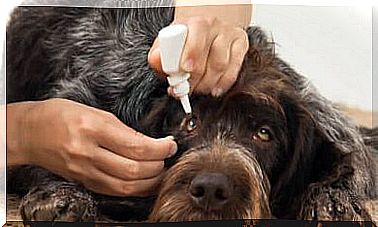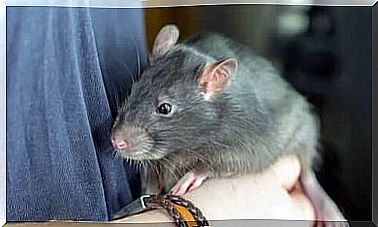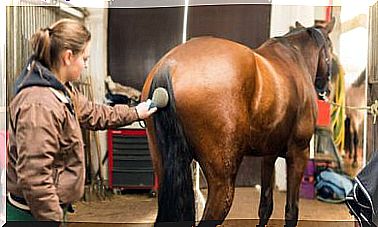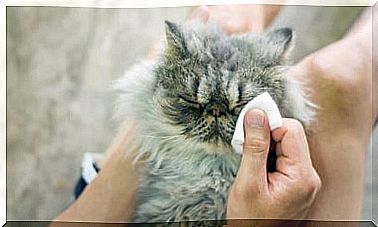Atopy: The Causes Of This Exaggerated Immune Reaction

Atopy is a very common pathology in cats and dogs. It is characterized by an exaggerated immune response, which manifests itself in the form of skin lesions in certain areas of the body. It is a condition with a fairly common incidence as 1 in 10 dogs will have it. In addition, estimates suggest that the incidence may continue to increase.
Atopy is also very common in humans and thus this disease is part of the daily life of many animals and people. In today’s article we want to show you some aspects that you should know about this skin disease.
What is an atopy?
Atopy, also known as atopic dermatitis, is a pathology with a high genetic predisposition. The scientific community describes it as a chronic disease, which means there is no cure. In addition, the body’s main reaction is an exaggerated immune response.
According to studies, the incidence of this pathology continues to increase over the years. This may be due to worsening environmental conditions and the link between allergens and various pollutants.
Although the pathogenesis of atopy is diverse and complex and specific features are shown in each individual case, there are still two central pathogenic mechanisms:
- Hypersensitivity to environmental allergens
- Change in skin barrier: A dysfunction of the body’s primary barrier to allergens is usually predictable.
Animals (or humans) with atopy respond to physical contact. These allergens interact via the mucous membranes or the skin, resulting in an atypical, exaggerated immune response of the animal’s immune system.

Symptoms of atopy
In general, atopy can be defined as an allergic reaction to different types of environmental allergens. The most common cause is mites, followed by pollen and, to a lesser extent, other allergens. Some of the most common symptoms seen with atopy include the following:
- Skin lesions
- Itching: severe local or general itching
- Peeling off the skin
An Exaggerated Immune Response: Finding the Symptoms
Animals respond to the itching by biting or scratching the affected area with their paws or claws. Another way to combat the discomfort is to rub against objects. All of this requires different manifestations in the skin, ranging from a reddish color to flakes of skin to areas of the body where the animal’s hair falls out.
In addition, you should very carefully examine where the lesions are on the animal’s body. Usually these occur in particular on the following areas of the body: the lips, stomach, eyes, skin folds or the distal part of the limbs.
Which criteria are relevant for the diagnosis?
When diagnosing this disease, the specialist will conduct a series of tests to confirm the potential suspicion. But before that, there are a few things you should consider. In the following, we will introduce you to the most important factors that are associated with this disease.
Medical history
Atopy is a disease with a high hereditary predisposition. It is therefore necessary to check whether the parent animals or other close relatives are suffering from it. Another relevant factor is the question of whether the animal had previously been treated for skin problems, what treatment was given and whether it was helpful. In addition, there are certain breeds of dogs that have a higher prevalence of this condition:
- French bulldog
- Dalmatian
- German shepherd dog
- poodle
- boxer
- Labrador Retriever
- Shar Pei
- terrier
Clinical picture
Since atopy has many symptoms that also occur with various other pathologies, it can even be confused with food allergies, for example. As a result, the vet will likely do an allergen test. This test consists of inoculating the animal with the most common allergens and observing which element provokes a reaction.
This is followed by a desensitization process. This consists in removing the allergens responsible for the disease from the environment of the animal. Some of them (mites, for example) are usually found in everyday items that are found in every household. Because mites usually live in carpets, bedspreads, mattresses or similar objects.
What treatment do doctors recommend for atopy?
First of all, it’s important that you take your dog to the vet to confirm or rule out a diagnosis of atopy. Based on this, the professional can then decide which treatment is best for your pet’s individual circumstances.
Some of the other things you should do are:
- Check for endo- and ectoparasites. If an animal with atopy is infested with parasites, it worsens the overall condition.
- In addition, you should bathe the animal frequently with a suitable shampoo. Experts recommend two to three baths a week.
- Your pet should also follow a specific diet. In pet shops you will find a large selection of feed that is suitable for this purpose.
- If the animal scratches itself uncontrollably , it is advisable to put an Elizabethan collar on it or use a cone to avoid further skin lesions.

The vet can also prescribe corticosteroids for your dog. However, these drugs can only be used to control symptoms. Therefore, you must follow the above treatments and grooming procedures throughout the pet’s life. The attending physician will recommend the frequency of the individual measures, taking into account the individual case.
Atopy is a pathology that occurs in young dogs and cats. Therefore, it is usually diagnosed by veterinarians between the ages of one and three. However, if you follow the doctor’s instructions, the disease can be controlled. If you have any questions or are unsure, you should always consult a specialist.









